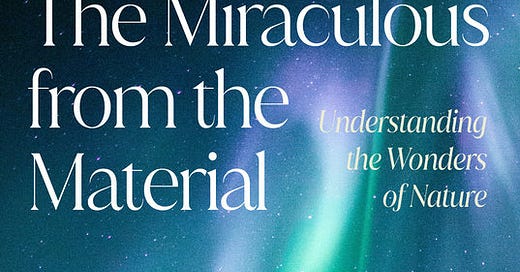There’s a very famous aside in The Feynman Lectures where he weighs in on one of the recurring themes in the debate between art and science:
Poets say science takes away from the beauty of the stars — mere globs of gas atoms. I too can see the stars on a desert night, and feel them. But do I see less or more? The vastness of the heavens stretches my imagination — stuck on this carousel my little eye can catch one-million-year-old light. A vast pattern — of which I am a part…. What is the pattern, or the meaning, or the why? It does not do harm to the mystery to know a little about it. For far more marvelous is the truth than any artists of the past imagined it. Why do the poets of the present not speak of it? What men are poets who can speak of Jupiter if he were a man, but if he is an immense spinning sphere of methane and ammonia must be silent?
I’m not the best guy to ask for this— I’m pretty strictly a prose writer, and poetry in general has way more misses than hits for me (aside from song lyrics)— but I agree with the general sentiment. Scientific understanding and aesthetic appreciation are complements, not opposites, and you can find awe in all manner of things. This is one of the things I was trying to do in Breakfast With Einstein— to show the sense of amazement that comes from thinking about quantum ideas and how they play out in the mundane world.
Alan Lightman’s new book, The Miraculous from the Material1 can be seen as him taking another book-length run at this issue:
This is a collection of about three dozen short essays, each accompanied by a glossy photo, delving into the science behind some natural phenomenon. These span a huge range— they run alphabetically from “Atmosphere” to “Yosemite Firefall” before a final piece on “Humans”— some obviously scientific (“Atoms,” “DNA,” “Paramecia”), some huge(“Galaxies,” “Stars”), and that seem some weirdly specific (“Failstreak Holes,” “Ha Long Bay”). Each of them gets a couple of pages of text describing the core phenomenon and what’s known of the science behind it, and also why this particular example was chosen.
The primary recurring theme here is wonder. In many cases a very personal kind of wonder— a good number of the essays describe experiences involving Lightman and his family— and in others a bit more of the abstract sense of scale that Feynman nods toward. Lightman also consistently works to connect the science directly to the sense of awe— musing on how the symmetric beauty of snowflakes and spiral plants emerges from microscopic physics, and extending that appreciation of symmetry to a grand scale— driving home the complementarity of the two experiences.
The essays are interconnected in ways that might seem surprising given the breadth of topics— “Ha Long Bay” is referenced remarkably often given how specific that reference seems. The explanations are all clear and concise, and also reinforce each other; they’re also on very solid ground scientifically (at least for those cases where I know enough to have an opinion about how to explain the phenomenon in question). They still for the most part stand alone, though; or fall, in a few cases where the attempt to wrap everything together ends up feeling a bit forced to me.
The success or failure of any individual essay is sort of beside the point, though, given the overall project. Whether you find, say, Mandarinfish or Scarlet Ibises particularly nifty as examples of evolution in action (or not) matters less than the cumulative effect of all of the essays together.
This is, all in all, a thoroughly charming book. And a well-timed one, in that we’re living in a world where we’re subjected to a constant drumbeat of “Everything Sucks.” There’s a pervasive atmosphere of doom and conflict, a war of all against all that renders everything unpleasant and ugly. In that context, it was especially refreshing to take a step back, breathe deeply, and be reminded that the various pieces of our universe fit together better than we’re sometimes led to believe, and that the combination is genuinely awe-inspiring when you take the time to appreciate it.
It’s still prose, though. Get to work, poets…
While Union’s not currently in session, I’m buried in work stuff, with this book review a quick respite. If you want more when there is more, here’s a button:
And if you have thoughts to share on art and science and the intercompatability thereof, the comments will be open:
Full disclosure: I was sent a free review copy of this by the nice folks at Random Penguin.





I love this. I have never understood the angle that science disenchants the world.
Thanks for the recommendation. Sounds good.